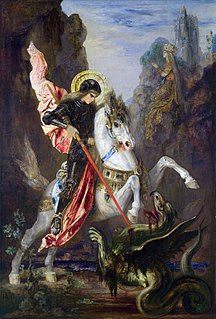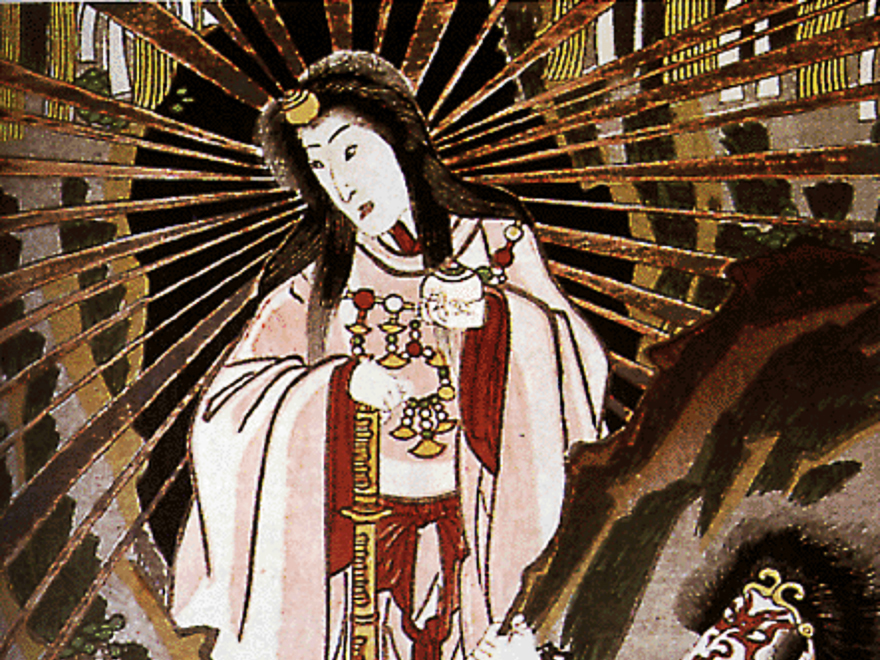Related Research Articles
American folklore encompasses the folklores that have evolved on the North American continent since Europeans arrived in the 16th century. While it contains much in the way of Native American tradition, it should not be confused with the tribal beliefs of any community of native people.

Christian mythology is the body of myths associated with Christianity. The term encompasses a broad variety of legends and stories, especially those considered sacred narratives. Mythological themes and elements occur throughout Christian literature, including recurring myths such as ascending to a mountain, the axis mundi, myths of combat, descent into the Underworld, accounts of a dying-and-rising god, flood stories, stories about the founding of a tribe or city, and myths about great heroes of the past, paradises, and self-sacrifice.

Joseph John Campbell was an American professor of literature at Sarah Lawrence College who worked in comparative mythology and comparative religion. His work covers many aspects of the human experience. Campbell's best-known work is his book The Hero with a Thousand Faces (1949), in which he discusses his theory of the journey of the archetypal hero shared by world mythologies, termed the monomyth.
Maya mythology is part of Mesoamerican mythology and comprises all of the Maya tales in which personified forces of nature, deities, and the heroes interacting with these play the main roles. The myths of the Pre-Hispanic era have to be reconstructed from iconography. Other parts of Mayan like oral tradition are not considered here.
Finnish mythology is a commonly applied description of the folklore of Finnish paganism, of which a modern revival is practiced by a small percentage of the Finnish people. It has many features shared with Estonian and other Finnic mythologies, but also shares some similarities with neighbouring Baltic, Slavic and, to a lesser extent, Norse mythologies.

In mythology, folklore and speculative fiction, shapeshifting is the ability to physically transform through an inherently superhuman ability, divine intervention, demonic manipulation, sorcery, spells or having inherited the ability. The idea of shapeshifting is in the oldest forms of totemism and shamanism, as well as the oldest existant literature and epic poems such as the Epic of Gilgamesh and the Iliad. The concept remains a common trope in modern fantasy, children's literature and popular culture.

Japanese mythology is a collection of traditional stories, folktales, and beliefs that emerged in the islands of the Japanese archipelago. Shinto and Buddhist traditions are the cornerstones of Japanese mythology. The history of thousands of years of contact with China, Korea, Ainu, and Okinawan myths are also key influences in Japanese mythology.
Georgian mythology refers to the mythology of pre-Christian Georgians.

Philippine mythology is the body of myths, tales, and belief systems held by Filipinos, originating from various cultures and traditions of the peoples of what eventually became the Philippines. Philippine mythology is incorporated from various sources, having similarities with Indonesian and Malay myths, as well as Hindu, Muslim, Shinto, Buddhist, and Christian traditions, such as the notion of heaven, hell, and the human soul. Philippine mythology attempts to explain the nature of the world through the lives and actions of deities, heroes, and mythological creatures. The majority of these myths were passed on through oral tradition, and preserved through the aid of community spiritual leaders or shamans and community elders.
Estonian mythology is a complex of myths belonging to the Estonian folk heritage and literary mythology. Information about the pre-Christian and medieval Estonian mythology is scattered in historical chronicles, travellers' accounts and in ecclesiastical registers. Systematic recordings of Estonian folklore started in the 19th century. Pre-Christian Estonian deities included a sky-god known as Jumal or Taevataat in Estonian, corresponding to Jumala in Finnish, and Jumo in Mari.
Comparative mythology is the comparison of myths from different cultures in an attempt to identify shared themes and characteristics. Comparative mythology has served a variety of academic purposes. For example, scholars have used the relationships between different myths to trace the development of religions and cultures, to propose common origins for myths from different cultures, and to support various psychological theories.

Turkic mythology features Tengriist and Shamanist strata of belief along with many other social and cultural constructs related to the nomadic existence of the Turkic peoples in early times. Later, especially after the Turkic migration, some of the myths were embellished to some degree with Islamic symbolism. Turkic mythology shares numerous points in common with Mongol mythology and both of these probably took shape in a milieu in which an essentially nationalist mythology was early syncretised with elements deriving from Tibetan Buddhism. Turkic mythology has also been influenced by other local mythologies. For example, in Tatar mythology elements of Finnic and Indo-European mythologies co-exist. Beings from Tatar mythology include Äbädä, Alara, Şüräle, Şekä, Pitsen, Tulpar, and Zilant. The early Turks apparently practised all the then-current major religions, such as Buddhism, Christianity, Judaism and Manichaeism, before the majority converted to Islam; often syncretising these other religions into their prevailing mythological understanding.

Moussa Sidi Yaya Dembélé is a Belgian professional footballer who plays as a central midfielder for Chinese Super League club Guangzhou R&F and the Belgium national team, for whom he has achieved 80 caps. He was regarded as one of the best box-to-box midfielders in Europe due to his excellent dribbling skills and ability to maintain possession.
Maldivian mythology or Maldivian folklore is the body of myths, tales and anecdotes belonging to the oral tradition of Maldivians. Even though some of the Maldivian myths were already mentioned briefly by British commissioner in Ceylon HCP Bell towards the end of the 19th century, their study and publication were carried out only quite recently by Spanish writer and artist Xavier Romero-Frias, at a time when that ancestral worldview was quickly disappearing.

Jewish mythology is a major literary element of the body of folklore found in the sacred texts and in traditional narratives that help explain and symbolize Jewish culture and Judaism. Elements of Jewish mythology have had a profound influence on Christian mythology and on Islamic mythology, as well as on world culture in general. Christian mythology directly inherited many of the narratives from the Jewish people, sharing in common the narratives from the Old Testament. Islamic mythology also shares many of the same stories; for instance, a creation-account spaced out over six periods, the legend of Abraham, the stories of Moses and the Israelites, and many more.

In mythology and the study of folklore and religion, a trickster is a character in a story which exhibits a great degree of intellect or secret knowledge and uses it to play tricks or otherwise disobey normal rules and defy conventional behavior. In the real world they may be real people who inhabit or take on this role either deliberately or with no conscious intent.

Greek mythology is the body of myths originally told by the ancient Greeks and a genre of Ancient Greek folklore. These stories concern the origin and the nature of the world, the lives and activities of deities, heroes, and mythological creatures, and the origins and significance of the ancient Greeks' own cult and ritual practices. Modern scholars study the myths in an attempt to shed light on the religious and political institutions of ancient Greece and its civilization, and to gain understanding of the nature of myth-making itself.
Azerbaijani folklore is the folk tradition of Azerbaijani people which has developed throughout the centuries. Azerbaijani folklore is embodied explicitly in a large collection of narratives and implicitly in representational arts, such as vase painting and votive gifts.

In narratology and comparative mythology, the Rank–Raglan mythotype is a set of narrative patterns proposed by psychoanalyst Otto Rank and later on amateur anthropologist Lord Raglan that lists different cross-cultural traits often found in the accounts of heroes, including mythical heroes.
The Hira is a mythical monster who occurs in epic and folklore tales of the Songhai people, particularly the Bozo people who traditionally lived from hunting and fishing along the Niger River. The main source are the tales collected by M. A. Dupuis Yakouba at the start of the twentieth century.
References
- ↑ Belcher, African Myths, 21, 459.
- ↑ Knappert, Jan (1967). "The Epic in Africa". Journal of the Folklore Institute . 4 (2/3): 171–90. doi:10.2307/3813996. JSTOR 3813996.
- ↑ Belcher, African Myths, 21-22.